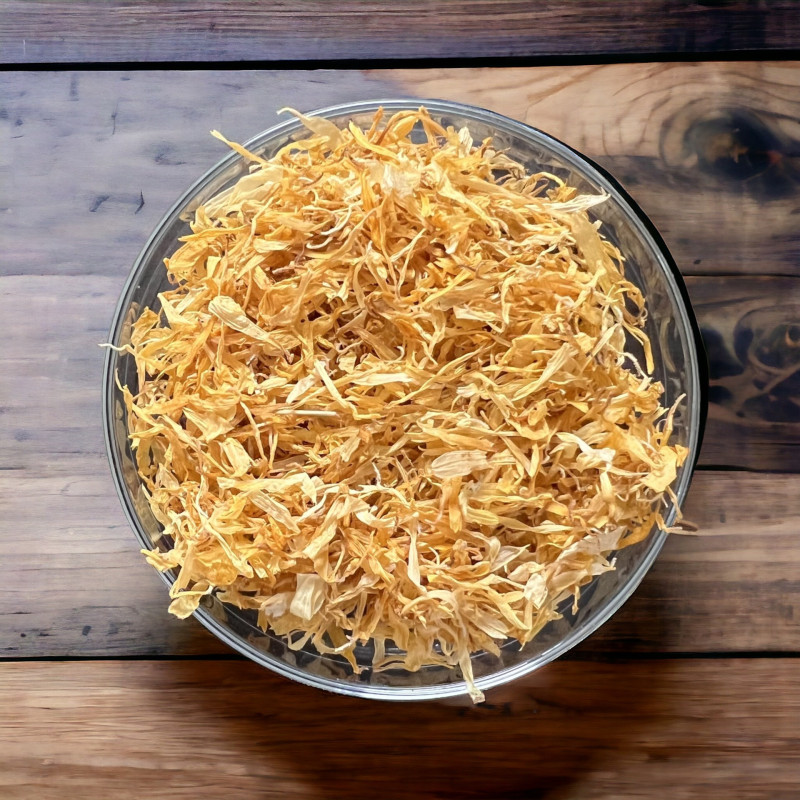- Reduced price



These beautifully sun-colored petals have a subtle rose-like taste and numerous medicinal properties.
They’ll brighten up your salads, surprising your guests, add charm to potpourris, and, most importantly, bring you their many benefits whether used in infusions or as an external lotion.
 Delivery
Delivery
Mondial Relay
 Returns
Returns
See conditions
 Payments
Payments
100% secure
Livré en sachet refermable
°°°
Les pétales de souci sont extrêmement légers:
15g non tassés ont un volume d'1/2 litre env. et de 25cl env. si on les tasse.
Uses in Cooking and Beyond:
Depending on the batch, the petals may be golden yellow or orange, but always vibrant in color.
The flavor of marigold petals is mild and pleasant, closely resembling rose.
Their bright, sunny color will illuminate your salads. Known as the “poor man’s saffron,” they have been used in cooking for centuries to color dishes. Infused in rice or pasta cooking water, they add a yellow hue. Marigold petals have been used since antiquity for their dyeing qualities, creating decoctions for textiles (yielding a cream-yellow color) and as a food colorant for deepening the hue of butter.
Marigold contains essential oils, 19 carotenoids, and salicylic acid, among other compounds. Externally (in lotions), it treats skin issues (acne, sunburn, fungal infections, minor wounds), oral and throat mucous membranes, eczema, and conjunctivitis. In infusions, it helps with digestive, liver, and gallbladder issues and supports female hormonal balance.
For this latter use, you can infuse 1 to 2 grams of petals in 150ml of boiling water for 5 to 10 minutes, drinking it several times throughout the day. Externally, apply the cooled infusion as compresses on affected areas. For mouth sores, use it as a mouthwash or gargle for a few minutes. No contraindications are known.
When planted in vegetable gardens, marigold repels pests.
Who Am I?
Origin: Egypt
Scientific Name: Calendula officinalis
Other Names: Garden marigold, pot marigold, poor man's saffron, calendula
This herbaceous plant, standing 40 to 70 cm tall, belongs to the Asteraceae family and has light green oval leaves and bright flowers that range from pale yellow to deep orange, blooming from spring to autumn. It is primarily found in Mediterranean regions (in gardens or wild in fallow lands). While its seeds withstand cold temperatures, the plant itself is sensitive to frost. Wild marigold, or “vine marigold,” is smaller but has the same properties.
When used in pharmaceutical preparations, it’s called “calendula.”
A Little History:
Despite what one might think, the origin of its name has nothing to do with concerns; it derives from the Latin solsequia, meaning “sun follower,” as its flowers open when the sun is high and close at night.
The properties of marigold were known to ancient Indian, Arab, and Greek civilizations. It has been recognized in Europe since the 12th century and was even one of the plants recommended by Charlemagne for royal estates starting in the 9th century.
Data sheet
Reference: bleuet
Reference: jasmin
Reference: rosepetale
Reference: rosepetale
Reference: 10M6810601
Reference: bleuet
Reference: 112390010
Reference: mauve
Reference: jasmin
Reference: rosepetale
Reference: 6M6533603
Reference: 26545D
Reference: camomilleRom
Reference: 408190301

These beautifully sun-colored petals have a subtle rose-like taste and numerous medicinal properties.
They’ll brighten up your salads, surprising your guests, add charm to potpourris, and, most importantly, bring you their many benefits whether used in infusions or as an external lotion.